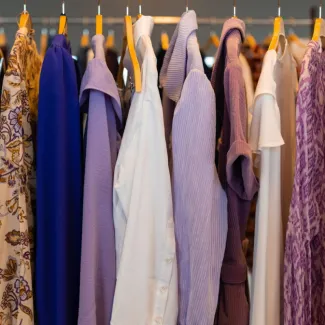Sustainable clothing: what is it and how can you recognise it in the store? Food for thought for producers and consumers
Clothing is a basic human need. At the same time, much clothing production often occurs in inhumane working conditions. Moreover, the fashion industry is one of the most polluting sectors, with a significant negative environmental and climate impact. This is primarily due to the prevailing business model in which clothing has a short lifespan, quickly wears out, and is then discarded. Fortunately, there has been a growing awareness of the importance of sustainability within the fashion industry in recent times. This is partly due to consumer demand, as consumers are better informed and consciously want to make purchases.
However, what can clothing producers do to make their offerings more sustainable, and how can consumers know if a garment or brand is sustainable? VITO sought and found some guidelines.

Sustainability is becoming increasingly integral across various sectors, including the fashion industry. For instance, fashion companies are deploying sustainability experts to guide decisions regarding fabric selection, production methods, and staff training to address sustainability inquiries effectively. VITO is actively promoting the transition to more circular business models across different domains, including the clothing sector (more info). In collaboration with Flanders DC and clothing brand Xandres, we have developed a practical design tool aimed at assisting the fashion industry in creating high-quality, sustainable clothing. This tool provides concrete recommendations to extend the lifespan of clothing. Additionally, VITO is involved in the European SCIRT project, which seeks to accelerate the transition to a circular fashion system. Through research initiatives, we aim to facilitate systemic changes throughout the value chain.
Sustainable production: bye bye to disposability
The disposable and overconsumption model of the fashion sector clashes with a more circular approach where clothing lasts much longer, partly because it is of higher quality but also because it can be repaired. CEO Inge Neven consulted with Xandres and immediately received an overview of how fashion companies can make their offerings more sustainable.
It starts with the choice of (raw) materials: the materials needed to produce clothing have a significant impact on the environment. The production of yarns and fabrics requires a considerable amount of water, energy, land, chemicals, and natural resources. Fashion companies can reduce this negative impact by using more recycled and certified materials, selecting higher quality fabrics that do not contain harmful chemicals. At the design stage, it is essential to move away from mass production and the sale of disposable fashion. More sustainable fashion companies design clothing of exceptional quality, with a focus on longevity and less waste. Another issue in the textile sector arises during production, often abroad and in dire working conditions. There too, clothing companies can make an impact by ensuring that their production takes place under the right ethical and environmental conditions. After production, it is important to make more sustainable choices regarding the transportation and packaging of clothing. Finally, after sale, a garment can be more sustainable if it is easy to maintain or repair, or if it finds a new purpose (preferably long-term) after use rather than ending up in a landfill.
Sustainable consumption: buy less, choose well, make it last
As a consumer, you can also have a significant impact on the fashion industry.
The renowned British fashion designer and activist Vivienne Westwood summed it up in her famous quote: "Buy less, choose well, make it last." That still holds true if you want to make a difference as a consumer and shop more sustainably.
- Buy less: The most sustainable clothing item is the one you already own. Try to resist trends and overconsumption. Invest in timeless, high-quality basics that are functional and easy to mix and match.
- Choose well: Look at the label and the material. Are they natural fibers, biodegradable, recyclable? Has consideration been given to animal welfare (avoid fur, angora, or skins of exotic animals) and where it is made?
- Make it last: Cherish your clothing and take care of it so that it lasts a long time. Textile waste is unfortunately still one of the biggest problems in the current disposable model of the fashion industry.
In summary, for a sustainable wardrobe, it's best to choose consciously and invest in sustainable, high-quality basics that have been produced with minimal impact on people, animals, the environment, and the climate. These items may come with a slightly higher price tag, but they last much longer, and by investing in them, you're not only investing in fashion but also in a more sustainable future.


